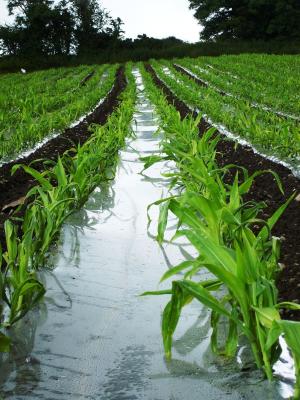AFBI trials show the value of plastic mulch to forage maize farmers
Date published:
For anyone planning to grow forage maize this year, the first decision is whether to use plastic mulch or not. For many this will be decided by their location. A lot of sites in Northern Ireland are too marginal to risk growing this crop without the insurance of plastic mulch to warm the soil and protect the young plants until they are large enough to break through.

For those, however, who have good free draining soils on sheltered sites, the decision is not so clear cut. The question that needs to be answered is “Why would I use the more expensive plastic mulch sowing system if I can often get as good a yield without it?”
This question has often been answered by growers choosing not to commit the extra finances for the plastic system ‘up front’ and relying on their good husbandry, good field conditions and the use of the correct recommended variety to produce a successful crop. For these growers, the truth of the matter is that they may not always need plastic to achieve a similar yield to many ‘plastic’ growers, but that’s where the similarity stops.
In Table 1 we have shown the 2013 yields for two recommended varieties sown under both systems in the same field.
On average, for the two varieties the plastic mulch has increased the final yield, but this was entirely due to Ambition’s extra 1.4 tonne per ha DM yield, as Kougar actually had a marginal reduction in yield under plastic. Kougar is a variety which we have recommended for open sowing for a number of years and is known to be resilient enough to retain its high yield potential without plastic mulch, in all but the most challenging growing seasons. Ambition is a new provisionally recommended variety for both systems and while a little weaker than Kougar in the open, gains much more from the plastic system.
While we at AFBI Crossnacreevy recommend varieties for both open and plastic sowing there are some fundamental differences which must be emphasised. Firstly, there is always more cost associated with sowing maize under plastic than in the open (around £300 per ha more). Secondly is the question of whether the yield gain with plastic can justify this cost. If fresh maize silage is valued at around £55 tonne (as was typically paid in 2013) then a 30% dry matter crop is costing £167 per tonne of dry matter in the pit. So with a yield gain of only 1.4 t per ha DM, Ambition fails to recoup the additional plastic cost and Kougar appears to represent a considerable loss to the grower. This might cause some to wonder why they paid extra for plastic back in spring.
So it is tempting for growers to compare the weight in trailer loads coming from an open grown crop with what is brought in from plastic mulched fields and conclude that the difference has not justified the high expense back in spring. However, this ignores the considerable difference in forage quality that normally exists between the two systems. Examining the Ambition and Kougar examples, it is clear that the dry matter contents are very different and this leads to equally large differences in starch yield. So when grown under plastic, Kougar produced 70% more starch and
Ambition produced 88% more starch. As the cost of producing this extra starch was the cost of laying the plastic (at £300 per ha) it is easy to calculate that the extra starch has cost around £118 per t (e.g. from the table: Plastic Starch Yield of 5.7t per ha minus Open Starch Yield of 3.2t per ha = 2.5t per ha at £300 per ha = £118 per tonne). As high energy concentrate feed, including starch based concentrates such as flaked maize costs around £230 per t to buy to replace extra starch grown by concentrate would cost £575 which is higher than the £300 cost of laying the plastic. On this evidence it is clear that the use of plastic can more than pay for itself even when there is little, if any, benefit in yield.
Many growers on more marginal sites will get much greater financial benefits from using plastic mulch as they will see much larger total dry matter and starch yield differences. Even so, those farmers with very favourable sites where open grown maize is a success, would still have had a lower cost of starch production had they paid extra in spring for the plastic system. Despite possibly not getting the yield gains experienced on poorer sites, these farmers will gain higher dry matters, higher starch yields and the additional bonus of a more consistently performing crop from year to year.
Regardless of which system a farmer chooses to use, success will depend on getting the correct variety for that system. This is where the AFBI testing programme ensures that only the most robust and high performing varieties get included on the DARD Recommended List. So this booklet is essential reading for all maize growers in Northern Ireland. The new list of varieties is now available in all DARD county offices. It is also availabler online at www.afbini.gov.uk/reclists or simply by inserting AFBI in any search engine.
by Dr Eamonn Meehan & Dr Trevor Gilliland, Plant Testing Station, AFBI-Crossnacreevy
Notes to editors:
AFBI carries out high quality technology research and development, statutory, analytical, and diagnostic testing functions for DARD and other Government departments, public bodies and commercial companies. AFBI's Vision is “Scientific excellence in Northern Ireland … serving the world”.All media enquiries to AFBI Press Office